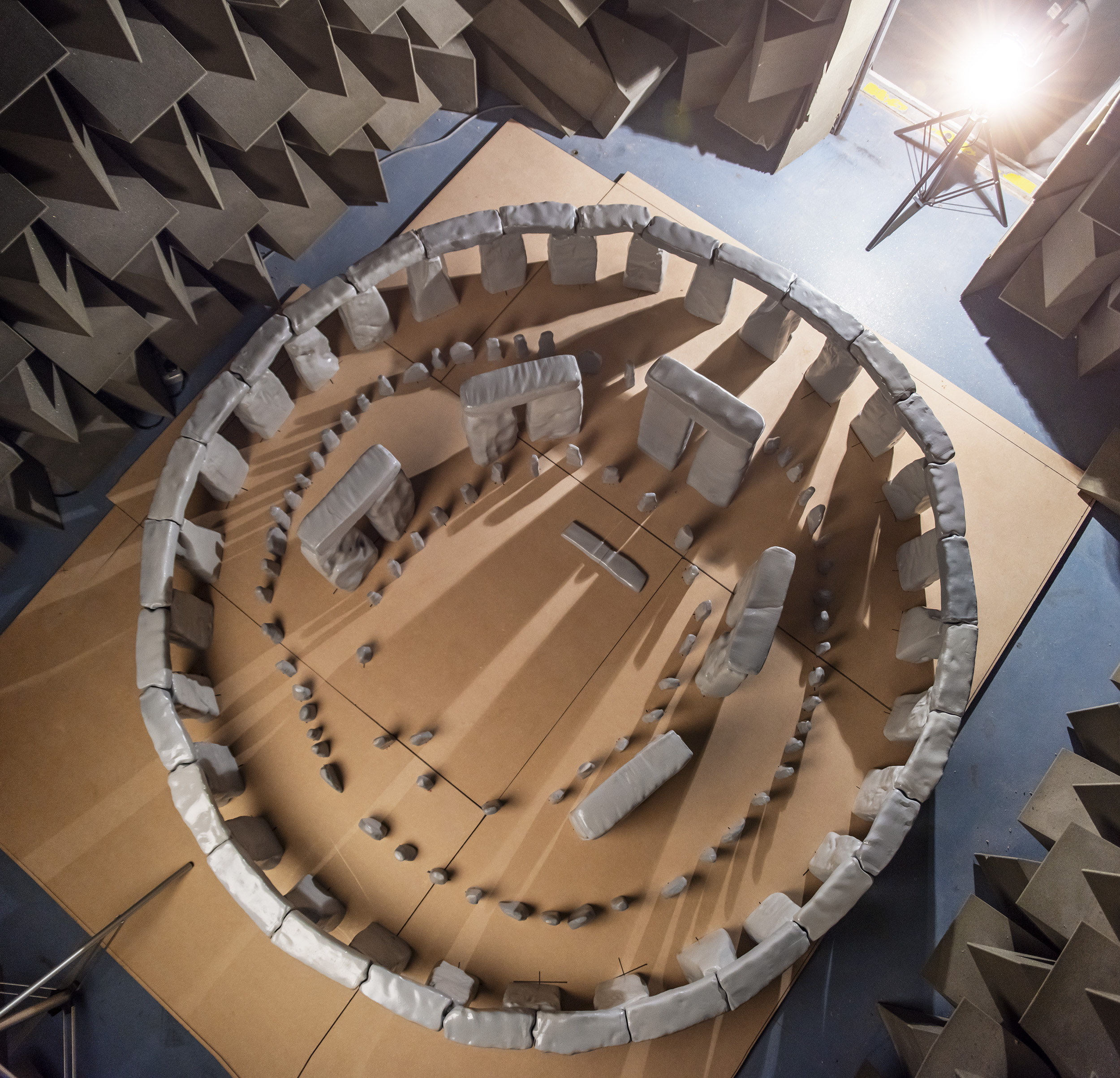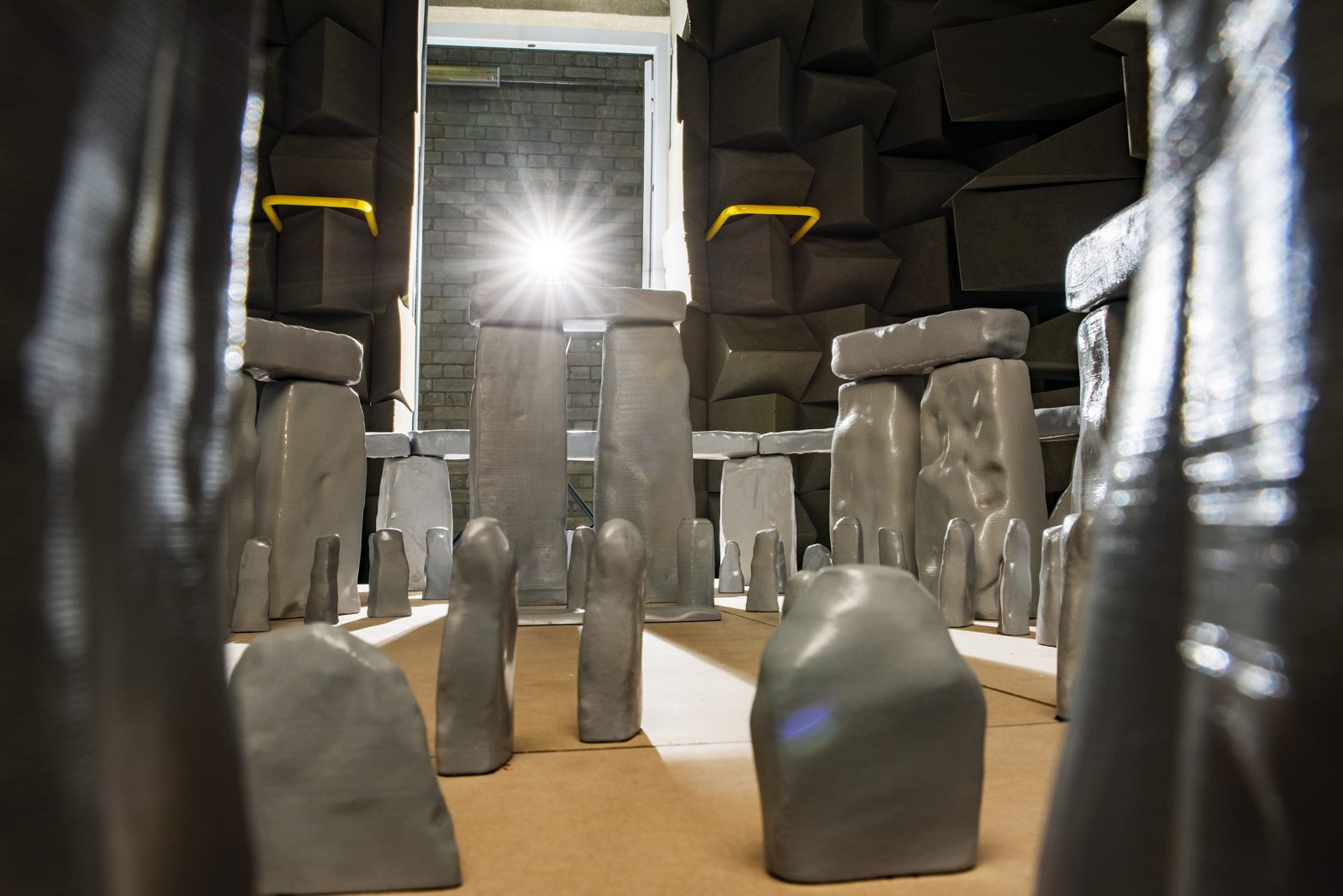Exactly what ceremonies took place in ancient Stonehenge isn’t known, but it would be incredibly surprising if they didn’t involve someone speaking. If you’re a celebrant trying to talk to a congregation, it’s usually important that your speech is loud enough it doesn’t get drowned out by any background noise. Sound reflections from the stones would have helped to amplify the voice and potentially improving communication.
Examining my measurements in the 1:12 acoustic scale model of Stonehenge can help quantify how useful these reflections were. Who was inside or outside the stone circle during ceremonies is unknown and much debated. As we’ll see below, it’s informative to look at the acoustics.

Below is an auralisation so you can hear the effect. First I’m talking in an anechoic chamber (a room with no reflections), and then you’ll hear a simulation of what I would have sounded like within Stonehenge. You can hear how my voice gets amplified by the reflections, alongside the timbre being altered.
Early reflections
We’ve all been in a large room like a cathedral where there’s plenty of amplification by reflections, but the speech is unintelligible. This happens if the reflections arrive too slowly. Any reflections arriving 50 milliseconds or later after the direct sound are detrimental to speech intelligibility. In contrast, reflections arriving earlier provide useful amplification. This is the basis for the Definition measure used in room acoustics (D50).
Figure 2 shows the D50 values for the 29 measurements where both the source and microphone were inside the stone circle. Large values are best, with D50 = 1 meaning all the sound reflections arrive within 50ms of the direct sound.
All but one measurement has a value of above 0.5 [1]. There is a useful graph in Kuttruff’s Room Acoustics [2], which shows that even with D50 = 0.5 you’re getting 90% speech intelligibility.

In terms of the balance between early and late reflections, Stonehenge is good for speech within the circle. But what about loudness, would the speech have been audible above other noise?
Strength
In performance spaces, loudness is gauged through a parameter called Strength, which is given the symbol G. It has a simple definition:
G = Lp,s – Lp,0
- Lp,s = sound level measured at the listener position with all the stones present.
- Lp,0 = sound level measurement at ten metres from the source in an anechoic chamber (no reflections just direct sound).
ISO 3382 recommends looking at G for an average of the mid-frequency octave bands of 500 and 1000 Hz, so that’s where I’ll start.

Figure 3 shows the strength for all 29 source-receiver measurements within the stone circle. It’s dominated by the natural drop in level you get when you move further from a sound source [3]. Any points above the blue line have benefited from amplification due to reflections.
As we’ve seen in a previous blog, whether stones block the direct route from the source to receiver is important to the acoustic conditions. If the line of sight between the source and receiver is occluded due to a stone being in the way, then loudness is less (black crosses in Figure 3). This is due to the attenuation of the direct sound. (Example impulse responses for occluded and clear line-of-sight cases were given in my previous blog). In contrast, the measurements with a clear line-of-sight are generally louder.
The average amplification caused by the stone reflections is (4.3 ± 0.9) dB. Consider a situation where you’re struggling to hear someone speaking because of noise, say the hubbub of other people at a ceremony. If the crowd was so noisy you’d only hear 50% of sentences correctly without the stones, then with the amplification of the stone circle you might pick up 95% of sentences correctly [4].
Let’s look at a specific scenario. A talker is 25 m away from a listener (the diameter of Stonehenge is about 30 m). Table 1 shows the speech levels arriving at a listener in an anechoic chamber (no reflections). The different rows are for different speaking volumes. The two columns of numbers show what happens if the talker faces the listener or speaks in the opposite direction.
| Level of speech at listener (dBA) | Level of speech at listener (dBA) | |
| Facing listener | Facing away from listener | |
| Soft | 22 | 15 |
| Normal | 32 | 24 |
| Loud | 45 | 37 |
Let’s assume the background noise level is 30 dB(A) [6] (fortunately our ancestors didn’t have to put up with the A303 road). The interesting cases are where the speech is quieter than the background noise level.
For speaking at a normal volume level, with the talker facing away from the listener, without the stones we have a signal to noise ratio of 24-30 = -6 dBA. That is problematic for hearing the speech. Below in Table 2 are the corresponding values with the stones present. The stone (and floor) reflections raise the the signal-to-noise ratio to -1 dBA for normal volume facing away.
| Level of speech at listener (dBA) | |
| Soft | 24 |
| Normal | 34 |
| Loud | 47 |
Using data from Figure 11 of reference [4], that change from -6 to +4 dBA would raise the number of sentences heard correctly from 33% to 100%. So, for cases where speech intelligibility is marginal, the stone reflections will help make the speech more intelligibile.
If the talker is facing the listener and shouting the stone reflections aren’t needed when the background is 30 dBA. But then we don’t know how rowdy the beaker people were, maybe the background level was higher.
Inside-outside
What does the acoustics tell us about how people might have used Stonehenge? Did the celebrant stand in the centre with the congregation outside the stone circle? Or were they all within the circle?
We made a series of measurements with the microphone just outside the circle of sarsens (roughly in the bottom left corner of the photo in Figure 1). We measured a drop of 4.5 dB and 9 dB for those external positions compared to ones of comparable source-receiver distance inside the circle [7]. The reason for two numbers is that the sound level depends on whether there was a line-of-sight to the sound source between the sarsen uprights.
4.5 and 9 dB are significant reductions in sound level compared to what you get within the circle. If everyone was in hushed reverence, and the celebrant shouted, then speech would still be intelligible outside. But what the acoustic measurements show, is it would be much easier if the speaker and listeners were all inside the circle.
Of course we don’t know how important speech intelligibility was to the ceremonies. We know from more recent history that intelligibility isn’t always important. For example, before the reformation Christian services were in Latin and so incomprehensible to the congregation [8].
I would never claim that Stonehenge was constructed for acoustic reasons, but what we can say, is that once it was constructed, it helped a little with speech communication within the circle. Going beyond speech intelligibility, studies have shown that louder talkers tend to be judged as more powerful and competent [9], so the celebrant would also create a better impression by exploiting the stone amplification.
Notes and references
Table 2 was updated on 9/4/20 as the calculation was refined.
[1] The measured result with D50 < 0.5 had the loudspeaker hidden right behind the largest trilithon (like it was playing hide-and-seek!). So no-wonder the intelligibility was poor.
[2] Kuttruff, H., 2016. Room Acoustics CRC Press. pp. 169.
[3] The R2 value is 0.66 for G vs log(x).
[4] This illustration used the sentence correct vs signal to noise ratio curve for a continuous noise masker from Rhebergen, K.S. and Versfeld, N.J., 2005. A speech intelligibility index-based approach to predict the speech reception threshold for sentences in fluctuating noise for normal-hearing listeners. The Journal of the Acoustical Society of America, 117(4), pp.2181-2192. The exact gain would depend on the type of speech and noise masker.
[5] Monson, B.B., Hunter, E.J. and Story, B.H., 2012. Horizontal directivity of low-and high-frequency energy in speech and singing. The Journal of the Acoustical Society of America, 132(1), pp.433-441.
[6] Lynch, E., Joyce, D. and Fristrup, K., 2011. An assessment of noise audibility and sound levels in US National Parks. Landscape ecology, 26(9), p.1297. This paper gives a natural background of 25 dB(A), I’m assuming there is also noise from other people raising this to 30 dB(A).
[7] An average of three measurement positions for each case. This is the reduction at 1000 Hz.
[8] Cox, T., 2014. Sonic wonderland: A scientific odyssey of sound. Random House.
[9] Peng, Y., Zebrowitz, L.A. and Lee, H.K., 1993. The impact of cultural background and cross-cultural experience on impressions of American and Korean male speakers. Journal of Cross-Cultural Psychology, 24(2), pp.203-220.
Follow me
One response to “Speech in Stonehenge”
[…] ← Speech in Stonehenge […]